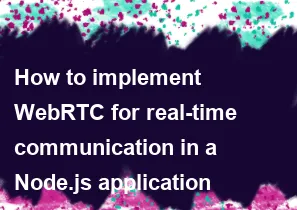How to implement WebRTC for real-time communication in a Node.js application

Implementing WebRTC (Web Real-Time Communication) for real-time communication in a Node.js application involves several steps. WebRTC is a powerful technology that enables peer-to-peer communication between web browsers. Here's a basic guide on how to implement WebRTC in a Node.js application:
Install Required Packages: First, you need to install the necessary Node.js packages. The
socket.iolibrary is commonly used for handling real-time communication, andsimple-peeris a WebRTC wrapper that simplifies the process.bashnpm install express socket.io simple-peerSet Up Your Express Server: Create an Express server to handle HTTP requests. This server will also serve the HTML and JavaScript files.
javascriptconst express = require('express'); const http = require('http'); const socketIO = require('socket.io'); const app = express(); const server = http.createServer(app); const io = socketIO(server); app.use(express.static('public')); server.listen(3000, () => { console.log('Server is running on http://localhost:3000'); });Create HTML and Client-Side JavaScript: Create an HTML file and include the necessary JavaScript code for handling WebRTC connections.
html<!-- public/index.html --> <!DOCTYPE html> <html lang="en"> <head> <meta charset="UTF-8"> <meta name="viewport" content="width=device-width, initial-scale=1.0"> <title>WebRTC Demo</title> </head> <body> <script src="/socket.io/socket.io.js"></script> <script src="https://cdn.jsdelivr.net/npm/simple-peer@9.2.1/simplepeer.min.js"></script> <script src="client.js"></script> </body> </html>javascript// public/client.js const socket = io(); const peer = new SimplePeer({ initiator: location.hash === '#init' }); peer.on('signal', (data) => { socket.emit('signal', data); }); socket.on('signal', (data) => { peer.signal(data); }); navigator.mediaDevices.getUserMedia({ video: true, audio: true }) .then((stream) => { // handle the stream, for example, display it in a video element document.getElementById('localVideo').srcObject = stream; peer.addStream(stream); }) .catch((error) => console.error(error));Handle WebRTC Signaling: Set up the signaling server using Socket.IO to exchange WebRTC signaling messages between clients.
javascript// server.js io.on('connection', (socket) => { socket.on('signal', (data) => { io.emit('signal', data); }); });Run Your Application: Start your Node.js server.
bashnode server.jsOpen two browser tabs and navigate to
http://localhost:3000#initin one tab andhttp://localhost:3000in the other. This will simulate two different users. They should be able to establish a WebRTC connection, and you can expand the functionality based on your requirements.
Remember that this is a basic example, and you might need to handle more complex scenarios, such as managing multiple peers, handling user disconnections, and dealing with NAT traversal issues. There are also more advanced libraries and frameworks available for building WebRTC applications in Node.js, such as simple-peer-server, socketcluster, and mediasoup.
-
Popular Post
- How to optimize for Google's About This Result feature for local businesses
- How to implement multi-language support in an Express.js application
- How to handle and optimize for changes in mobile search behavior
- How to handle CORS in a Node.js application
- How to use Vue.js with a UI framework (e.g., Vuetify, Element UI)
- How to configure Laravel Telescope for monitoring and profiling API requests
- How to create a command-line tool using the Commander.js library in Node.js
- How to implement code splitting in a React.js application
- How to use the AWS SDK for Node.js to interact with various AWS services
- How to use the Node.js Stream API for efficient data processing
- How to implement a cookie parser middleware in Node.js
- How to implement WebSockets for real-time communication in React
-
Latest Post
- How to implement a dynamic form with dynamic field styling based on user input in Next.js
- How to create a custom hook for handling user interactions with the browser's device motion in Next.js
- How to create a custom hook for handling user interactions with the browser's battery status in Next.js
- How to implement a dynamic form with dynamic field visibility based on user input in Next.js
- How to implement a dynamic form with real-time collaboration features in Next.js
- How to create a custom hook for handling user interactions with the browser's media devices in Next.js
- How to use the useSWRInfinite hook for paginating data with a custom loading indicator in Next.js
- How to create a custom hook for handling user interactions with the browser's network status in Next.js
- How to create a custom hook for handling user interactions with the browser's location in Next.js
- How to implement a dynamic form with multi-language support in Next.js
- How to create a custom hook for handling user interactions with the browser's ambient light sensor in Next.js
- How to use the useHover hook for creating interactive image zoom effects in Next.js